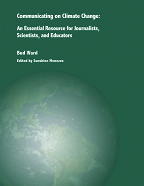SEJournal Online is the digital news magazine of the Society of Environmental Journalists. Learn more about SEJournal Online, including submission, subscription and advertising information.

BookShelf
Reviewed by STEFAN MILKOWSKI
The science of climate change can be daunting. While the basic idea of anthropogenic warming is fairly simple and well understood, the mechanics behind it can be quite complex. Chemistry, physics, and biology all play critical roles.
Amid that complexity, public skepticism has flourished, especially in the U.S. As warnings grew sharper and other nations embraced ambitious plans, Americans remained largely skeptical of the basic idea that humans are warming the globe.
Yet compared to other environmental problems, where sources are fewer and impacts are more localized, climate change arguably demands a much greater public understanding. Public engagement is needed to spur political action and to change personal behavior.
So who's to blame for leaving the public in the dark just when light is needed the most? According to Communicating on Climate Change, written by SEJ founding member Bud Ward, scientists and the media are both at fault.
News organizations have given relatively little space to an issue that "oozes but doesn't break," in the words of New York Times reporter Andrew Revkin. When they have, the journalistic principle of balance has all too often given disproportionate weight to sources skeptical of the science.
Scientists, for their part, have generally shied away from using the media to convey their findings, even when their research is relevant to the general public.
The difference in language and norms of the two professions has also limited the quality of coverage, as has the reluctance of reporters and scientists alike to be seen as advocates.
Ward, editor of the Web-based Yale Forum on Climate Change & the Media, seeks to explain this failure in communication and offer creative solutions for improving coverage.
The book is the product of a series of workshops organized by the Metcalf Institute for Marine & Environmental Reporting between November 2003 and September 2007. The workshops brought together scientists and reporters to discuss media coverage of climate change. "Frustration was the impetus," Ward writes in the first chapter.
The Metcalf Institute published Ward's book as continuing education for scientists and journalists. It includes chapters such as "Science for journalists," which offers a 101 on scientific method and peer review, and "What scientists can do," which encourages scientists to be patient when explaining complex science to someone lacking a scientific background.
The book also includes essays from prominent scientists and journalists on topics ranging from the ethics of using video provided by sources to how climate change is taught in public schools. SEJ co-founder Jim Detjen argues for credentialing of climate reporters. Climate researcher Ben Santer examines the political environment that allowed author Michael Crichton to be considered a climate expert. And Revkin explains his efforts to get climate change on the front page without overstating the science.
Ward tosses out some thought-provoking ideas, such as forming an AP-like news agency for climate change reporting. He rightly notes that scientists and reporters share the goal of informing the public about climate change. But at times the book has the feel of a written Kumbaya, with any gripes between sources and the media quickly set aside.
Because the book is written for scientists and teachers, not just media folks, some of its contents will be obvious to reporters, especially those on the environmental beat. That said, it offers many ideas that aren't obvious. "As a truth barometer, have scientists identify experts in their field whose conclusions differ, but whom they nonetheless believe to be reputable scientists," is one example. "Encourage reporting staffs to look at climate change not just as a science or environment story," is another.
Workshops are often stimulating and valuable but the lessons learned can fade quickly. Communicating on Climate Change provides a key service in gathering the most perceptive observations and constructive ideas from a half-dozen multi-day workshops into a readable, 74-page synopsis.
Ward notes that media coverage of climate change increased over the course of the workshops and the tone of the coverage changed. Reporting started to reflect scientists' confidence in the basic theory even if many readers remained skeptical. And in some cases, such as linking stronger hurricanes to climate change, the news media even jumped ahead of the science.
Communicating on Climate Change remains relevant despite the shift. Its analysis and recommendations – for bridging the professional divide between scientists and reporters to cover an important and complex issue – make the book a valuable resource for journalists and scientists alike.
The book is available for free download at the Metcalf Institute Web site.
Stefan Milkowski is a freelance writer living in Fairbanks, Alaska, and former reporter for the Fairbanks Daily News-Miner. He won a first-place award for best series from the Alaska Press Club for his climate change stories in 2008.
** From SEJ's quarterly newsletter, SEJournal Spring, 2009 issue.












 Advertisement
Advertisement 



